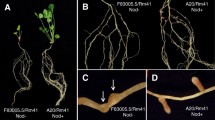Abstract
One of the most fascinating, and still largely unexplained, aspects of Rhizobium/Bradyrhizobium- legume interaction is the host specificity exhibited. Investigations of Rhizobium meliloti and R. leguminosarum bv. viciae and trifolii have shown that host specificity is determined by the respective nodD gene as well as unique host specificity genes (reviewed in Long 1989). Against this background of work with various Rhizobium species, comparatively little is known about the determinants of host specificity in Bradyrhizobium species. Clearly, the specificity of the nodD gene product for specific isoflavone inducers from the plant plays an important role in legume infection by Bradyrhizobium (Kosslak et a1 1988; Banfalvi et al 1988). In addition, a few loci have been identified by mutagenesis in Bradyrhizobium that appear to affect nodulation on only particular host species (Bender et al 1987; Nieuwkoop et al 1987; Hahn and Hennecke 1988).
Access this chapter
Tax calculation will be finalised at checkout
Purchases are for personal use only
Preview
Unable to display preview. Download preview PDF.
Similar content being viewed by others
References
Banfalvi Z, Nieuwkoop, A, Schell M., Besl L and Stacey G (1988) Regulation of nod gene expression in Bradyrhizobium japonicum. Mol Gen Genet 214: 420–424
Bender GL, Goydych W, Rolfe BG and Nayudu M (1987) The role of Rhizobium conserved and host-specific nodulation genes in the infection of the non-legume Parasponia andersonii. Mol Gen Genet 210: 299–306
Beynon JL, Cannon MC, Buchanan-Wollaston V and Cannon FC (1983) The nif promoters of Klebsiella pneumoniae have a characteristic primary structure. Cell 34: 665–671
Buck M, Miller S, Drummond M, and Dixon R (1986) Upstream activator sequences are present in the promoters of nitrogen fixation genes. Nature 320: 374–378
Deshmane N and Stacey G (1989) Identification of Bradyrhizobium nod genes involved in host specific nodulation. J Bacteriol 171: 3324–3330
Fischer H-M, Alvarez-Morales A and Hennecke H (1986). The pleiotropic nature of symbiotic regulatory mutants: Bradyrhizobium japonicum nifA gene is involved in control of nif gene expression and formation of determinate symbiosis. EMBO J 5: 1165–1173
Hahn M and Hennecke H (1988) Cloning and mapping of a novel nodulation region from Bradyrhizobium japonicum by genetic complementation of a deletion mutant. Appl Environ Microbiol 54: 55–61
Harnisch U, Weiss H and Siebald W (1985) The primary structure of the iron- sulfur subunit of ubiquinolcytochrome C reductase from Neurospora, determined by cDNA and gene sequencing. Eur J Biochem 149: 95–99
Kosslak RM, Bookland R, Barkei J, Paaren HE and Appelbaum ER (1987) Induction of Bradyrhizobium japonicum common nod genes by isoflavones isolated from Glycine max. Proc Natl Acad Sci 84: 7428–7432
Long SR (1989) Rhizobium-legume nodulation: Life together in the underground. Cell 56: 203–214
Nieuwkoop AJ, Banfalvi Z, Deshmane N, Gerhold D, Schell MG, Sirotkin KM and Stacey G (1987) A locus encoding host range is linked to the common nodulation genes of Bradyrhizobium japonicum. J Bacteriol 169: 2631–2638
Stachel SE, An G, Flores C and Nester EW (1985) A Tn3LacZ transposon for the random generation of O-galactosidase gene fusions: application to the analysis of gene expression in Agrobacterium. EMBO J 4: 891–898
Steppuhn J, Rother C, Hermans J, Jansen T, Salnikow, J, Hauska G and Herrmann RG (1987) The complete amino acid sequence of the Rieske FeS-precursor protein from spinach chloroplasts deduced by cDNA analysis. Mol Gen Genet 210: 171–177
Author information
Authors and Affiliations
Editor information
Editors and Affiliations
Rights and permissions
Copyright information
© 1989 Springer-Verlag Berlin Heidelberg
About this paper
Cite this paper
Stacey, G., Schell, M.G., Deshmane, N. (1989). Determinants of Host Specificity in the Bradyrhizobium Japonicum-Soybean Symbiosis. In: Lugtenberg, B.J.J. (eds) Signal Molecules in Plants and Plant-Microbe Interactions. NATO ASI Series, vol 36. Springer, Berlin, Heidelberg. https://doi.org/10.1007/978-3-642-74158-6_48
Download citation
DOI: https://doi.org/10.1007/978-3-642-74158-6_48
Publisher Name: Springer, Berlin, Heidelberg
Print ISBN: 978-3-642-74160-9
Online ISBN: 978-3-642-74158-6
eBook Packages: Springer Book Archive




